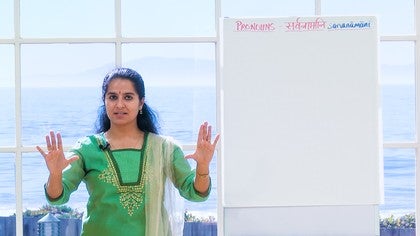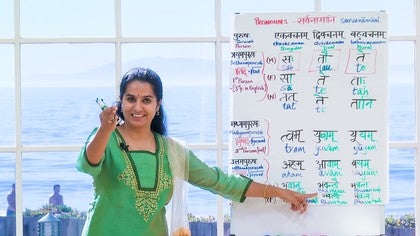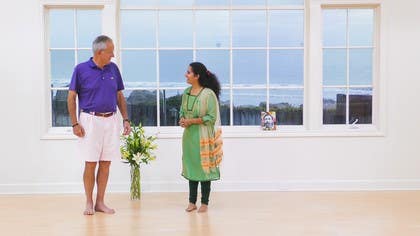Description
About This Video
Transcript
Read Full Transcript
Namaste dear friends, thus far we have been exploring different words and trying to build a Sanskrit vocabulary and what we noticed was that when you are looking at a Sanskrit noun, the most important thing is the gender. So you have to look at the ending of the word to know which gender that word belongs to. Is it masculine, feminine or neuter? Now nouns in any language can also be replaced by other words which are known as pronouns. So if in English we said the man goes, when we replace the words the man with a pronoun we would say he goes.
Let's look at it in the Sanskrit language and the way it is drawn out is like the English game of tic-tac-toe. So I will put that grid there for you. We have so the rows represent the person who is doing that action. So in the first block we would have the third person or what in English is the he she it in the singular. So we have the person here represented and in this case it is the third person and on top we have the numbers so it's a singular.
The second column has the dual or two people and the third has more than three so three plus so one person, two people and more than three and when you go down the rows we get third person which is he she it, he she it and then we get the second person which is the you so that's the second person and it is the you and then we have the first person or the I. So that's the first person and it is the I. Then we move on to the second square so in Sanskrit we have this whole second column which is about pronouns for two people it's a unique unit. So when we talk of the second column we have he or they too. Now by they you have to understand that it is he she it all three of them are represented by that and then similarly we have the you too, you too and then we have it for the first person so we too, we too great and then you have the plural so for the third person you have the singular the dual and many of them they go for example they many and then we have the in the second person you have you singular you dual and you plural so you all go you all let's say many go and then we have in the first person I we too and us or we many we.
So we have this grid that you need to remember third person second person first person singular dual and plural if you have that you're really fine another another pronoun that we will be looking at also is the you formal in that we have a masculine and a feminine but just to give you the ideas very simply I'll write it as so that's the second person formal alright and this is the informal we have you masculine and feminine and then similarly you can imagine there is you too masculine and feminine and finally you you all or you many masculine and feminine have a look at this grid well get it clearly embedded in your mind because everything that we do from here onwards will always have a reference to this so once you have that clearly understood we'll put in the Sanskrit words and it will be easy for you so look forward to seeing you with a lot more of Sanskrit many other forms of the pronoun enjoy learning them namaste.







You need to be a subscriber to post a comment.
Please Log In or Create an Account to start your free trial.